Multivariate Monitoring of Surface Water Quality: Physico-Chemical, Microbiological and 3D Fluorescence Characterization
Abstract
1. Introduction
2. Materials and Methods
2.1. Study Area
2.2. Sampling and Analytical Procedures
2.3. Multivariate Analyses
2.3.1. Principal Component Analysis (PCA)
2.3.2. ComDim Method
3. Results and Discussions
3.1. Study of Bivariate Correlations
3.2. Multivariate Study of Water Characteristics
3.2.1. Spatial Study by PCA—The Two Rivers, all Sites, All Parameters
3.2.2. Spatial Study by PCA—The Two Rivers, All Variables, Excluding Sites KA5 and KA6
3.2.3. Temporal Study by PCA
3.2.4. Surface Water Monitoring: Use of Multivariate Fingerprints
3.2.5. ComDim on 3D Fluorescence Data
4. Conclusions
Supplementary Materials
Author Contributions
Funding
Acknowledgments
Conflicts of Interest
References
- United Nations. Sustainable Development Goals. Water Action Decade. Available online: https://www.un.org/sustainabledevelopment/water-action-decade/ (accessed on 3 June 2020).
- Alberto, W.D.; Del Pilar, D.M.; Valeria, A.M.; Fabiana, P.S.; Cecilia, H.A.; Ángeles, B.M.d.l. Pattern Recognition Techniques for the Evaluation of Spatial and Temporal Variations in Water Quality. A Case Study. Water Res. 2001, 35, 2881–2894. [Google Scholar] [CrossRef]
- Kowalkowski, T.; Zbytniewski, R.; Szpejna, J.; Buszewski, B. Application of chemometrics in river water classification. Water Res. 2006, 40, 744–752. [Google Scholar] [CrossRef] [PubMed]
- Gazzaz, N.M.; Yusoff, M.K.; Ramli, M.F.; Aris, A.Z.; Juahir, H. Characterization of spatial patterns in river water quality using chemometric pattern recognition techniques. Mar. Pollut. Bull. 2012, 64, 688–698. [Google Scholar] [CrossRef] [PubMed]
- Walker, D.; JakovljeviĆ, D.; Savic, D.; Radovanovic, M. Multi-criterion water quality analysis of the Danube River in Serbia: A visualisation approach. Water Res. 2015, 79, 158–172. [Google Scholar] [CrossRef]
- Daou, C.; Salloum, M.; Legube, B.; Kassouf, A.; Ouaini, N. Characterization of spatial and temporal patterns in surface water quality: A case study of four major Lebanese rivers. Environ. Monit. Assess. 2018, 190, 485. [Google Scholar] [CrossRef]
- Ates, N.; Kitis, M.; Yetis, U. Formation of chlorination by-products in waters with low SUVA—Correlations with SUVA and differential UV spectroscopy. Water Res. 2007, 41, 4139–4148. [Google Scholar] [CrossRef]
- Barbosa, M.O.; Ribeiro, A.R.; Ratola, N.; Hain, E.; Homem, V.; Pereira, M.F.R.; Blaney, L.; Silva, A.M. Spatial and seasonal occurrence of micropollutants in four Portuguese rivers and a case study for fluorescence excitation-emission matrices. Sci. Total Environ. 2018, 644, 1128–1140. [Google Scholar] [CrossRef]
- Powers, L.; Luek, J.L.; Schmitt-Kopplin, P.; Campbell, B.J.; Magen, C.; Cooper, L.; Gonsior, M. Seasonal changes in dissolved organic matter composition in Delaware Bay, USA in March and August 2014. Org. Geochem. 2018, 122, 87–97. [Google Scholar] [CrossRef]
- Yan, C.; Liu, H.; Sheng, Y.; Huang, X.; Nie, M.; Huang, Q.; Baalousha, M. Fluorescence characterization of fractionated dissolved organic matter in the five tributaries of Poyang Lake, China. Sci. Total. Environ. 2018, 1311–1320. [Google Scholar] [CrossRef]
- Murphy, K.R.; Hambly, A.; Singh, S.; Henderson, R.K.; Baker, A.; Stuetz, R.M.; Khan, S.J. Organic Matter Fluorescence in Municipal Water Recycling Schemes: Toward a Unified PARAFAC Model. Environ. Sci. Technol. 2011, 45, 2909–2916. [Google Scholar] [CrossRef]
- Kannel, P.R.; Lee, S.; Kanel, S.; Khan, S.P. Chemometric application in classification and assessment of monitoring locations of an urban river system. Anal. Chim. Acta 2007, 582, 390–399. [Google Scholar] [CrossRef] [PubMed]
- Barakat, A.; El Baghdadi, M.; Rais, J.; Aghezzaf, B.; Slassi, M. Assessment of spatial and seasonal water quality variation of Oum Er Rbia River (Morocco) using multivariate statistical techniques. Int. Soil Water Conserv. Res. 2016, 4, 284–292. [Google Scholar] [CrossRef]
- Daou, C.; Nabbout, R.; Kassouf, A. Spatial and temporal assessment of surface water quality in the Arka River, Akkar, Lebanon. Environ. Monit. Assess. 2016, 188, 684. [Google Scholar] [CrossRef] [PubMed]
- Wang, J.; Liu, G.; Liu, H.; Lam, P.K.; Lam, P.K. Multivariate statistical evaluation of dissolved trace elements and a water quality assessment in the middle reaches of Huaihe River, Anhui, China. Sci. Total Environ. 2017, 583, 421–431. [Google Scholar] [CrossRef] [PubMed]
- Fernandes, A.; Fernandes, L.F.S.; Cortes, R.; Pacheco, F. The Role of Landscape Configuration, Season, and Distance from Contaminant Sources on the Degradation of Stream Water Quality in Urban Catchments. Water 2019, 11, 2025. [Google Scholar] [CrossRef]
- Qannari, E.M.; Wakeling, I.; Courcoux, P.; MacFie, H.J. Defining the underlying sensory dimensions. Food Qual. Preference 2000, 11, 151–154. [Google Scholar] [CrossRef]
- El Ghaziri, A.; Cariou, V.; Rutledge, D.N.; Qannari, E.M. Analysis of multiblock datasets using ComDim: Overview and extension to the analysis of (K + 1) datasets. J. Chemom. 2016, 30, 420–429. [Google Scholar] [CrossRef]
- Karoui, R.; Dufour, E.; Schoonheydt, R.; De Baerdemaeker, J. Characterisation of soft cheese by front face fluorescence spectroscopy coupled with chemometric tools: Effect of the manufacturing process and sampling zone. Food Chem. 2007, 100, 632–642. [Google Scholar] [CrossRef]
- Ministry of Environment (MOE). State of the Environment Report (SOER), Lebanon. MOE, UNDP and ECODIT, p. 47, 2010. Available online: http://www.undp.org.lb/communication/publications/downloads/SOER_en.pdf. (accessed on 3 September 2019).
- Massoud, M.A.; El-Fadel, M.; Scrimshaw, M.; Lester, J. Factors influencing development of management strategies for the Abou Ali River in Lebanon. Sci. Total. Environ. 2006, 362, 15–30. [Google Scholar] [CrossRef]
- Kabbara, N.; Benkhelil, J.; Awad, M.; Barale, V. Monitoring water quality in the coastal area of Tripoli (Lebanon) using high-resolution satellite data. ISPRS J. Photogramm. Remote Sens. 2008, 63, 488–495. [Google Scholar] [CrossRef]
- Association Française de Normalisation (AFNOR) (French Association for Standardization). Qualité de l’eau—Recueil de Normes Françaises (Water Quality—Collection of French Standards); Association Française de Normalisation: Paris, France, 1994. [Google Scholar]
- Cordella, C.B.; Bertrand, D. SAISIR: A new general chemometric toolbox. TrAC Trends Anal. Chem. 2014, 54, 75–82. [Google Scholar] [CrossRef]
- Bouroche, J.M.; Saporta, G. L’analyse des données. Collection Que sais-je? In Data Analysis. Collection What Do I Know; Presses Universitaires de France: Paris, France, 1992. [Google Scholar]
- Singh, K.P.; Malik, A.; Sinha, S. Water Quality Assessment and Apportionment of Pollution Sources of Gomti River (India) Using Multivariate Statistical Techniques—A Case Study. Anal. Chim. Acta 2005, 538, 355–374. [Google Scholar] [CrossRef]
- Bouveresse, D.J.-R.; Pinto, R.C.; Schmidtke, L.; Locquet, N.; Rutledge, D. Identification of significant factors by an extension of ANOVA–PCA based on multi-block analysis. Chemom. Intell. Lab. Syst. 2011, 106, 173–182. [Google Scholar] [CrossRef]
- Rosa, L.N.; De Figueiredo, L.C.; Bonafé, E.G.; Coqueiro, A.; Visentainer, J.V.; Março, P.H.; Rutledge, D.N.; Valderrama, P. Multi-block data analysis using ComDim for the evaluation of complex samples: Characterization of edible oils. Anal. Chim. Acta 2017, 961, 42–48. [Google Scholar] [CrossRef]
- Bouhlel, J.; Bouveresse, D.J.-R.; Abouelkaram, S.; Baéza, E.; Jondreville, C.; Travel, A.; Ratel, J.; Engel, E.; Rutledge, D.N. Comparison of common components analysis with principal components analysis and independent components analysis: Application to SPME-GC-MS volatolomic signatures. Talanta 2018, 178, 854–863. [Google Scholar] [CrossRef]
- Bouza-Deaño, R.; Rodriguez, M.T.; Fernández-Espinosa, A. Trend study and assessment of surface water quality in the Ebro River (Spain). J. Hydrol. 2008, 361, 227–239. [Google Scholar] [CrossRef]
- Varol, M. Spatio-temporal changes in surface water quality and sediment phosphorus content of a large reservoir in Turkey. Environ. Pollut. 2020, 259, 113860. [Google Scholar] [CrossRef]
- Tang, J.; Li, X.; Cao, C.; Lin, M.; Qiu, Q.; Xu, Y.; Ren, Y. Compositional variety of dissolved organic matter and its correlation with water quality in peri-urban and urban river watersheds. Ecol. Indic. 2019, 104, 459–469. [Google Scholar] [CrossRef]
- Razmkhah, H.; Abrishamchi, A.; Torkian, A. Evaluation of spatial and temporal variation in water quality by pattern recognition techniques: A case study on Jajrood River (Tehran, Iran). J. Environ. Manag. 2010, 91, 852–860. [Google Scholar] [CrossRef]
- Vega, M.; Pardo, R.; Barrado, E.; Deban, L. Assessment of seasonal and polluting effects on the quality of river water by exploratory data analysis. Water Res. 1998, 32, 3581–3592. [Google Scholar] [CrossRef]
- El Najjar, P.; Kassouf, A.; Probst, A.; Probst, A.; Ouaini, N.; Daou, C.; El Azzi, D. High-frequency monitoring of surface water quality at the outlet of the Ibrahim River (Lebanon): A multivariate assessment. Ecol. Indic. 2019, 104, 13–23. [Google Scholar] [CrossRef]
- Ruždjak, A.M.; Ruždjak, D. Evaluation of river water quality variations using multivariate statistical techniques. Environ. Monit. Assess. 2015, 187, 1–14. [Google Scholar] [CrossRef]
- Zheng, L.-Y.; Yu, H.-B.; Wang, Q.-S. Assessment of temporal and spatial variations in surface water quality using multivariate statistical techniques: A case study of Nenjiang River basin, China. J. Central South Univ. 2015, 22, 3770–3780. [Google Scholar] [CrossRef]
- Ustaoğlu, F.; Tepe, Y.; Taş, B. Assessment of stream quality and health risk in a subtropical Turkey river system: A combined approach using statistical analysis and water quality index. Ecol. Indic. 2020, 113, 105815. [Google Scholar] [CrossRef]
- Karakaya, N.; Evrendilek, F. Water quality time series for Big Melen stream (Turkey): Its decomposition analysis and comparison to upstream. Environ. Monit. Assess. 2009, 165, 125–136. [Google Scholar] [CrossRef] [PubMed]
- David, A.; Tournoud, M.-G.; Perrin, J.-L.; Rosain, D.; Rodier, C.; Salles, C.; Bancon-Montigny, C.; Picot, B. Spatial and temporal trends in water quality in a Mediterranean temporary river impacted by sewage effluents. Environ. Monit. Assess. 2012, 185, 2517–2534. [Google Scholar] [CrossRef]
- Chen, W.; Westerhoff, P.; Leenheer, J.A.; Booksh, K. Fluorescence Excitation−Emission Matrix Regional Integration to Quantify Spectra for Dissolved Organic Matter. Environ. Sci. Technol. 2003, 37, 5701–5710. [Google Scholar] [CrossRef]
- Xie, M.-W.; Chen, M.; Wang, W.-X. Spatial and temporal variations of bulk and colloidal dissolved organic matter in a large anthropogenically perturbed estuary. Environ. Pollut. 2018, 243, 1528–1538. [Google Scholar] [CrossRef]
- Galinha, C.F.; Carvalho, G.; Portugal, C.; Guglielmi, G.; Reis, M.A.M.; Crespo, J.G. Two-dimensional fluorescence as a fingerprinting tool for monitoring wastewater treatment systems. J. Chem. Technol. Biotechnol. 2011, 86, 985–992. [Google Scholar] [CrossRef]
- Klimenko, N.A.; Samsoni-Todorova, E.A.; Savchina, L.A.; Lavrenchuk, I.N.; Zasyad’Ko, T.N. Seasonal variations of characteristics of organic matter in the Dnieper River water. J. Water Chem. Technol. 2012, 34, 154–161. [Google Scholar] [CrossRef]

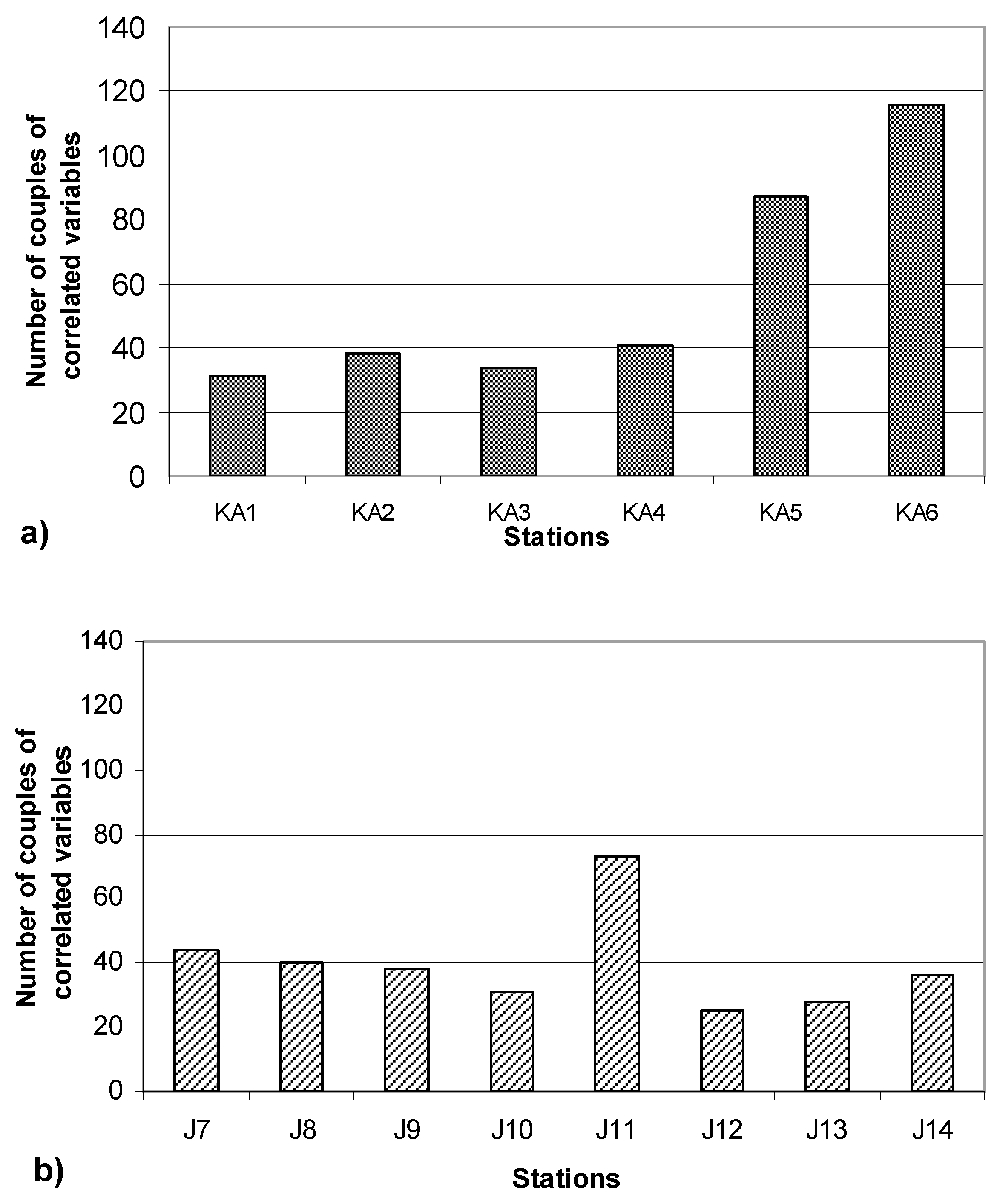
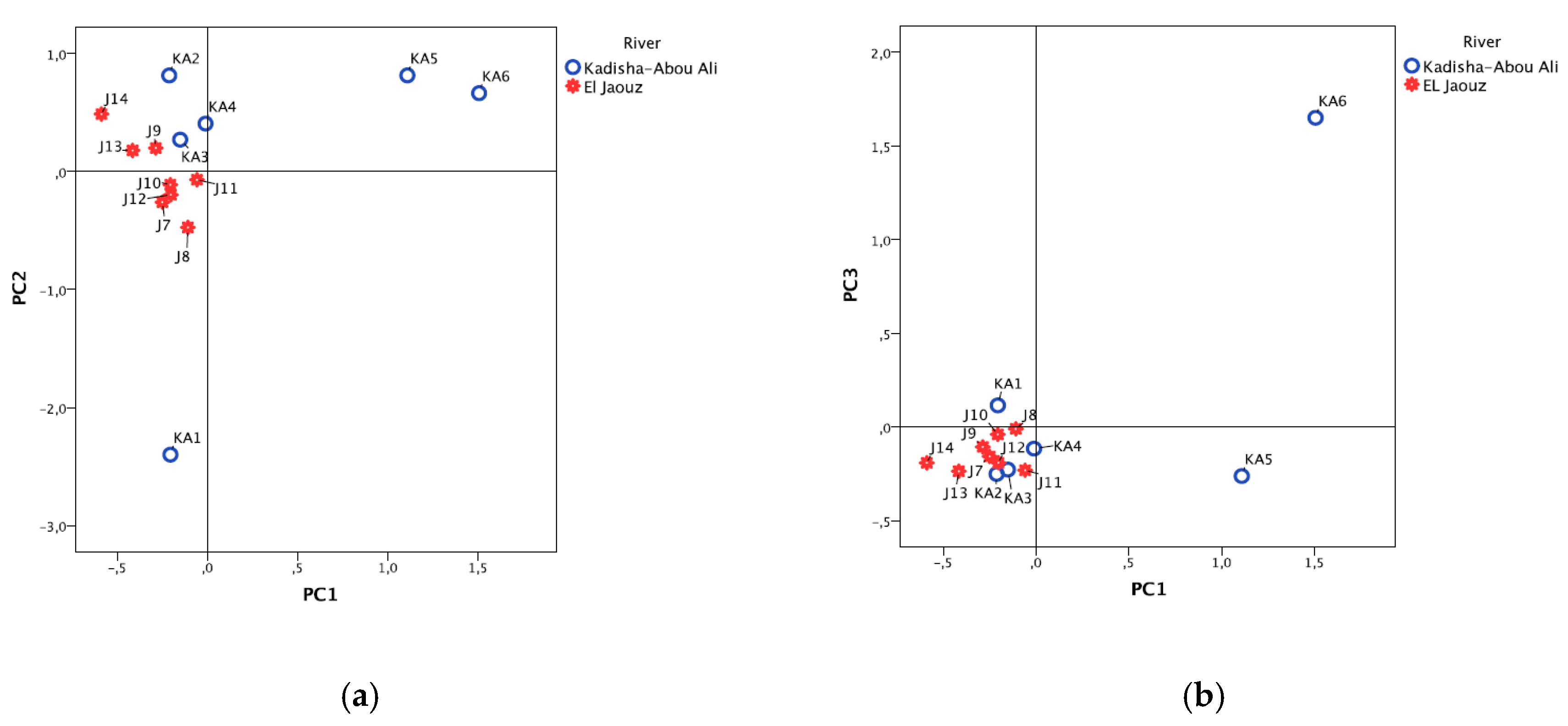
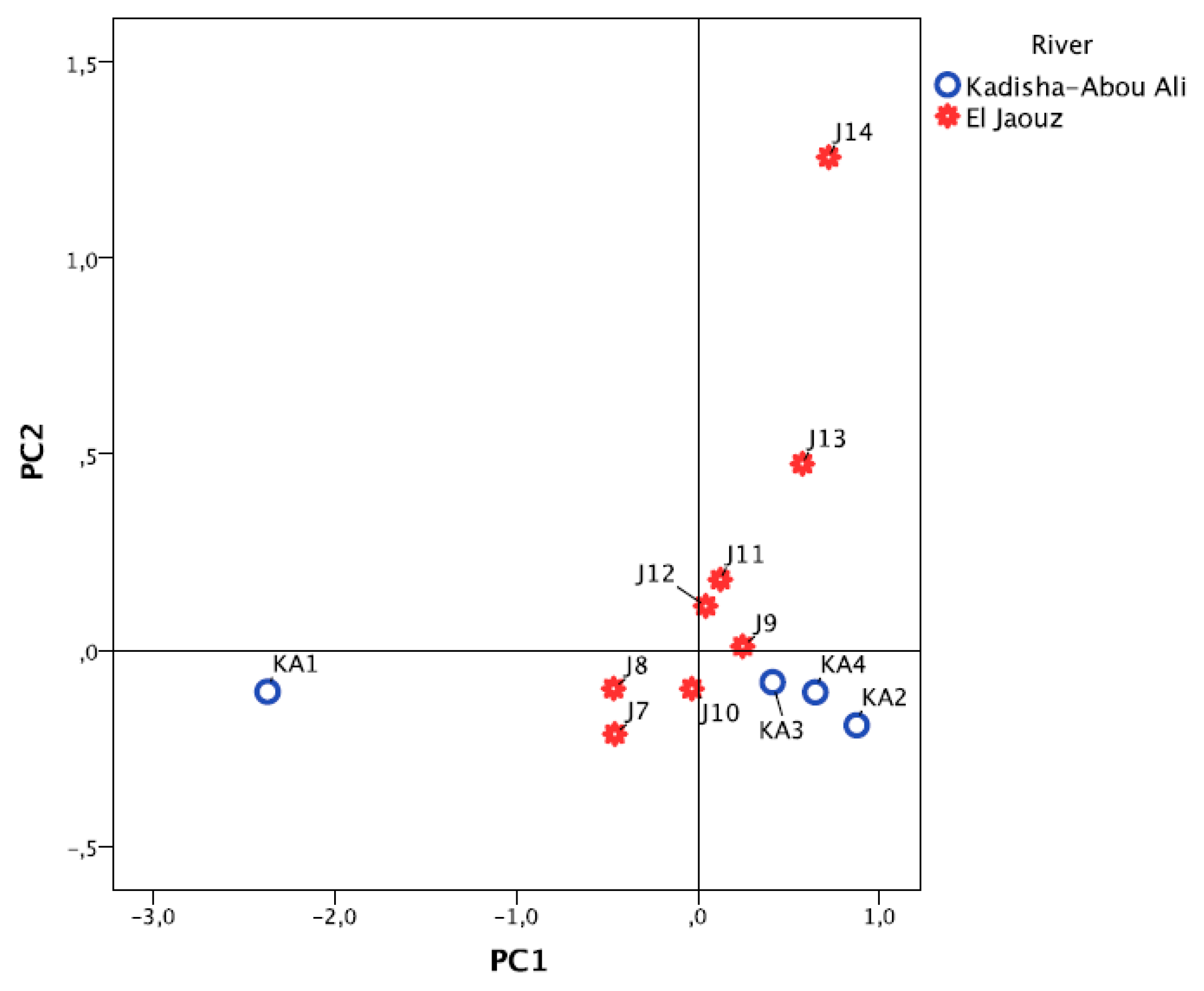
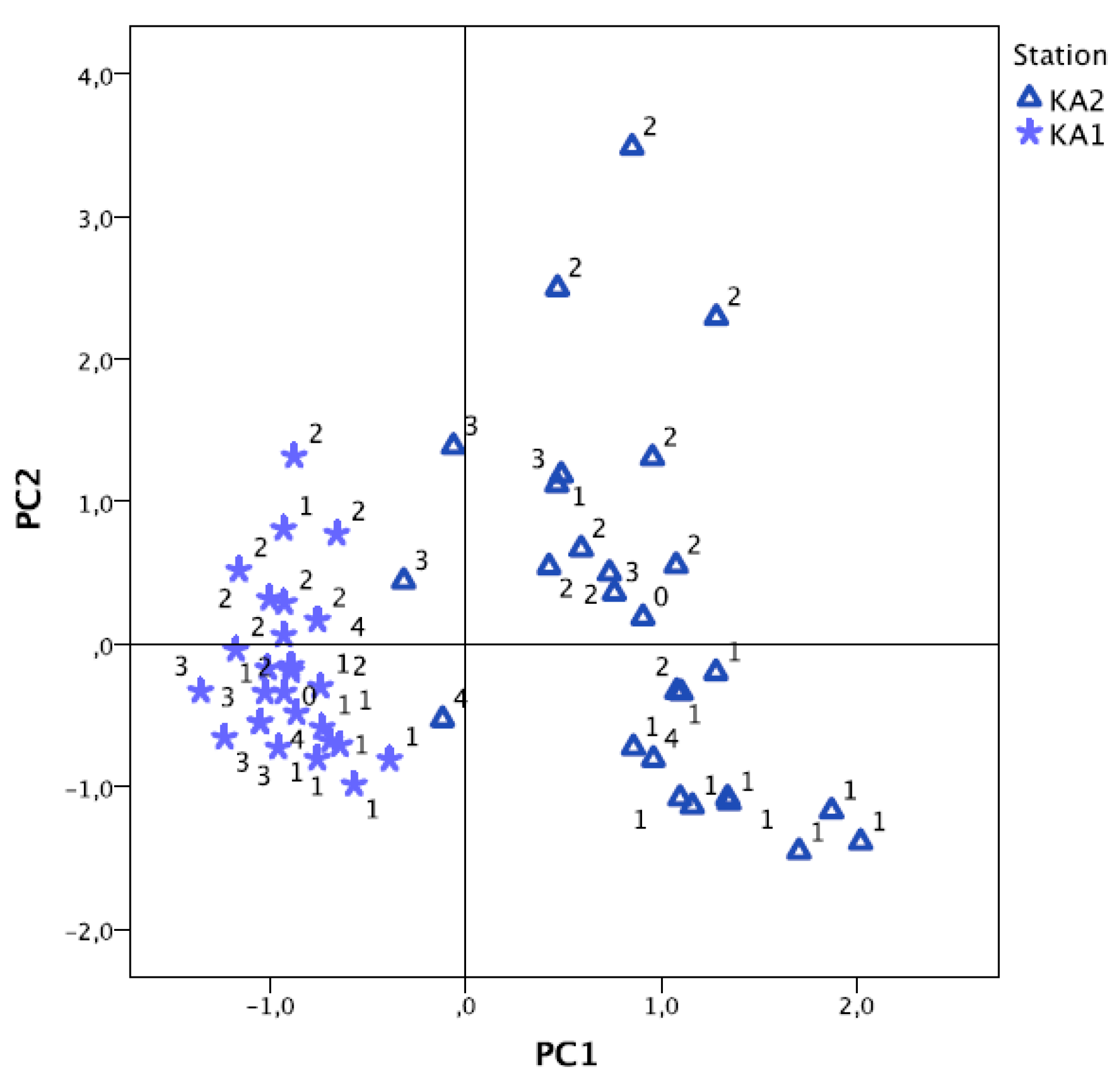
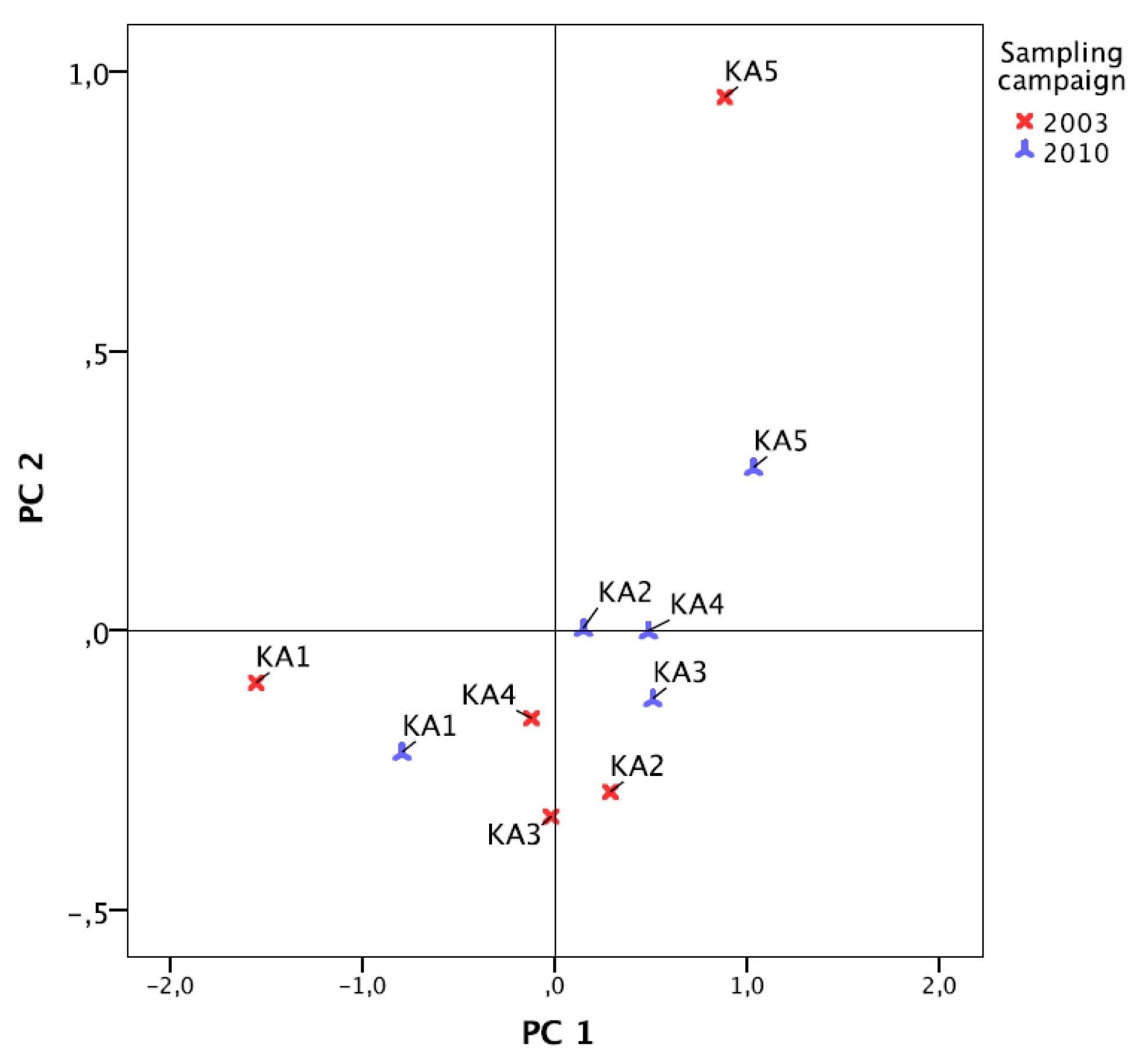
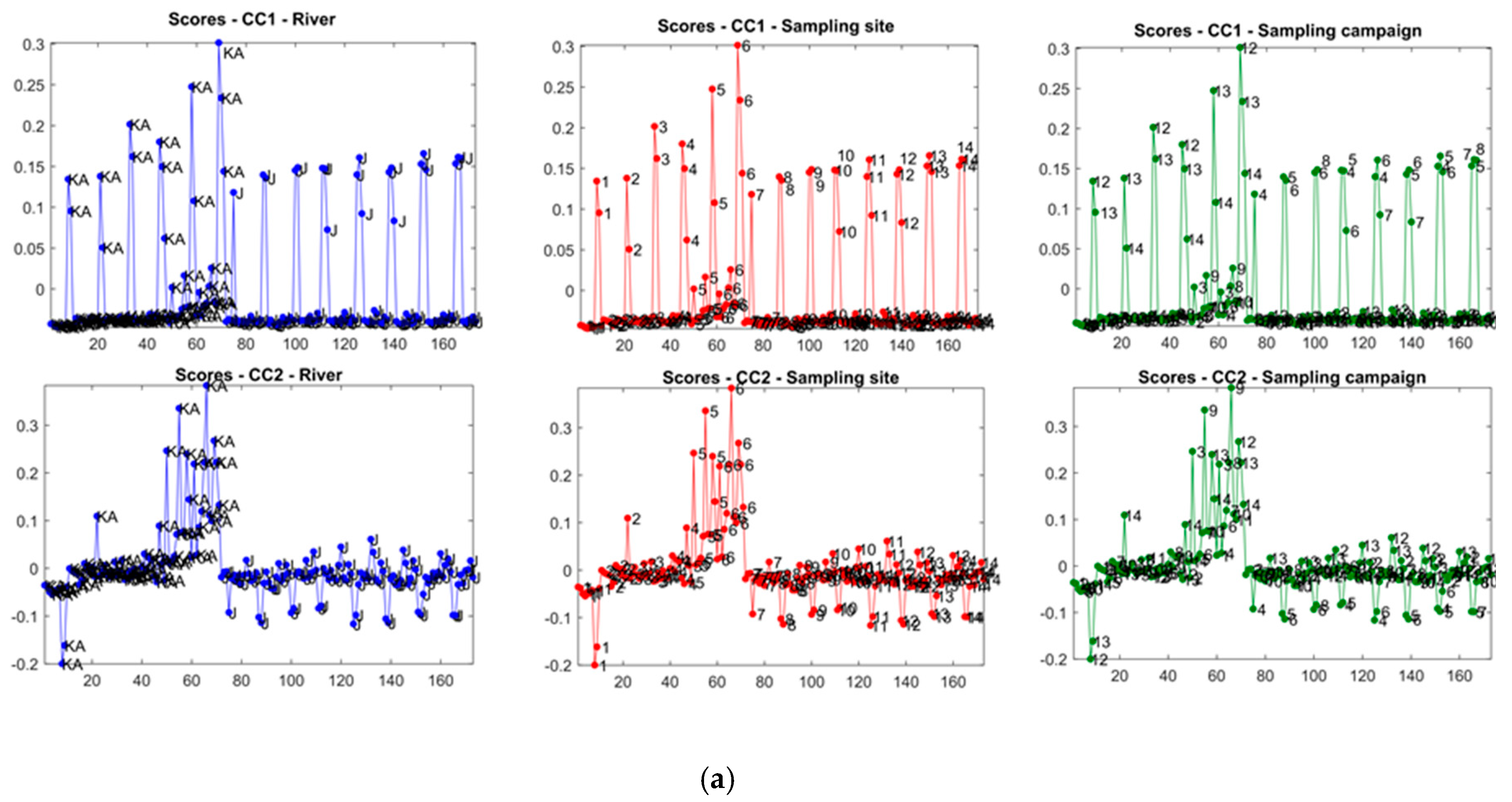
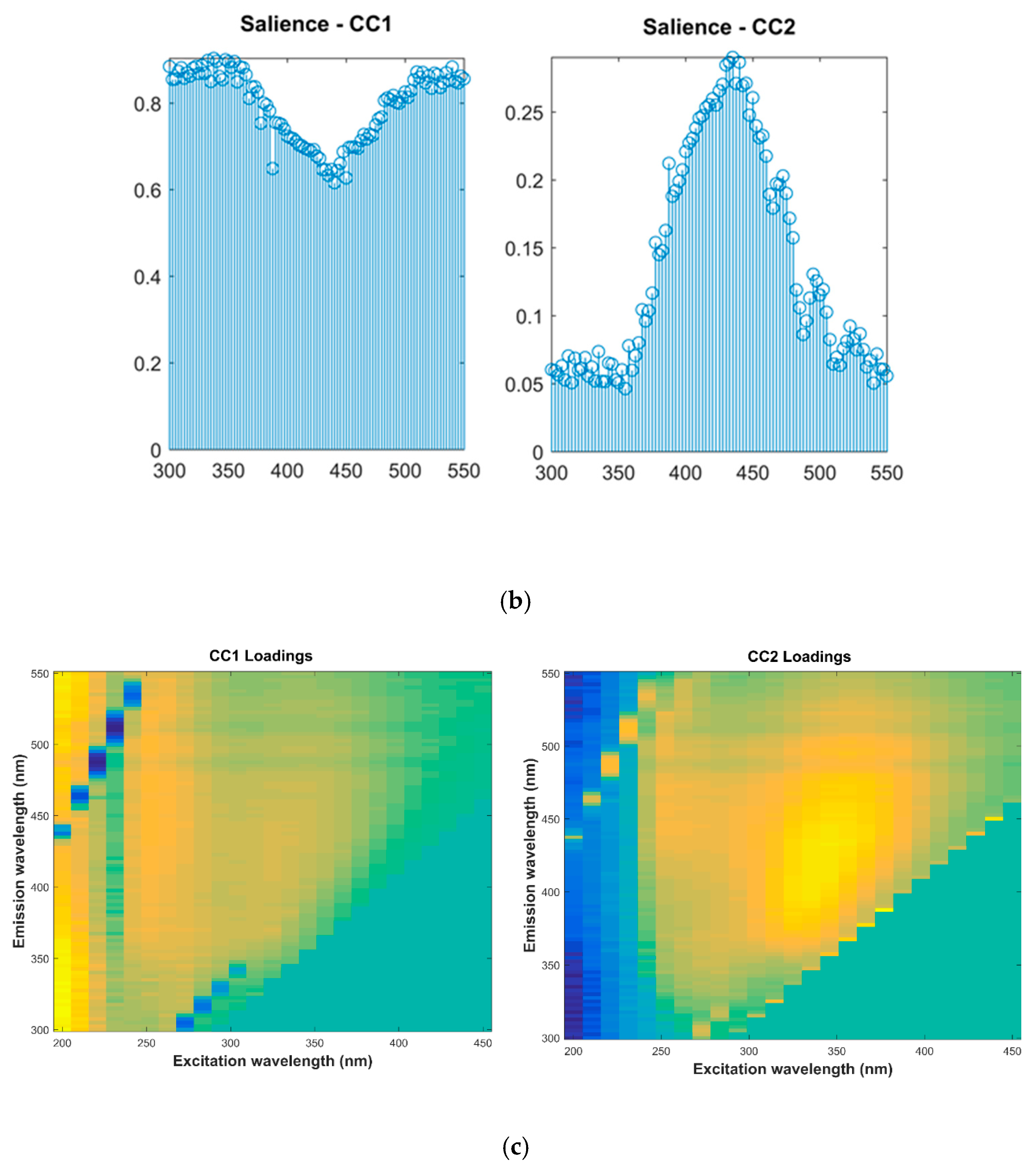
| Parameters | Abbreviation | Method | Parameters | Abbreviation | Method |
|---|---|---|---|---|---|
| Temperature (°C) | T° | Potentiometer HORIBA U10 | Chemical oxygen demand (mg O2/L) | COD | NF T 90-101 |
| pH | pH | Potentiometer HORIBA U10 | Alkalinity (meq/L) | TA | NF T 90-036 |
| Conductivity (µS/cm) | EC | Potentiometer HORIBA U10 | Chloride (mg Cl−/L) | Cl | NF T90-014 |
| Dissolved Oxygen (mg O2/L) | DO | Potentiometer HORIBA U10 | Total count (CFU/100 mL) | TotGerms | NF T 90-401 |
| Turbidity (NTU) | Turb | Potentiometer HORIBA U10 | Total Coliforms (CFU/100 mL) | TotColif | NF T 90-414 |
| Redox (mV, H) | E | Potentiometer WTW pH 330 i | Fecal Coliforms (CFU/100 mL) | FecColif | NF T 90-414 |
| Suspended Solids (mg/L) | SS | NF T 90-105 | Fecal Streptococci (CFU/100 mL) | StrepD | NF T 90-416 |
| Orthophosphate (µg P/L) | PO4 | NF T 90-023 | Sodium (mg/L) | Na | ICP |
| Total Phosphorus (µg P/L) | P | NF T 90-023 | Calcium (mg/L) | Ca | ICP |
| Nitrates (mg NO3−/L) | NO3 | NF T 90-045 | Potassium (mg/L) | K | ICP |
| N ammonia (mg N/L) | NH4 | NF T 90-015 | Magnesium (mg/L) | Mg | ICP |
| UV Absorbance at 254 nm | Abs254 | Spectrophotometry UV/visible | Iron (µg/L) | Fe | ICP |
| Sulfates (mg SO42−/L) | SO4 | NF T 90-009 | Manganese (µg/L) | Mn | ICP |
| Silicates (mg SiO2/L) | SiO2 | NF T 90-007 | Barium (µg/L) | Ba | ICP |
| Dissolved organic carbon (mg C/L) | DOC | Shimadzu TOC-VCSH | Aluminum (µg/L) | Al | ICP |
| Variable | Component | |||||
|---|---|---|---|---|---|---|
| 1 | 2 | 3 | 4 | 5 | 6 | |
| Abs254 | 0.875 | 0.088 | 0.183 | 0.039 | 0.032 | 0.037 |
| NH4 | 0.786 | 0.144 | 0.228 | 0.263 | −0.018 | −0.034 |
| DOC | 0.759 | 0.160 | 0.237 | −0.058 | 0.089 | −0.038 |
| K | 0.704 | 0.444 | 0.357 | 0.194 | 0.088 | 0.097 |
| SS | 0.623 | 0.126 | 0.104 | 0.169 | 0.128 | 0.128 |
| Mn | 0.611 | 0.186 | 0.198 | 0.178 | 0.488 | 0.105 |
| Na | 0.554 | 0.509 | 0.420 | 0.343 | −0.014 | 0.058 |
| Mg | 0.019 | 0.825 | 0.032 | −0.087 | 0.103 | 0.023 |
| Ca | 0.255 | 0.790 | 0.156 | 0.206 | 0.103 | −0.036 |
| EC | 0.171 | 0.673 | 0.269 | 0.395 | −0.017 | −0.188 |
| TA | 0.316 | 0.639 | −0.047 | 0.119 | −0.186 | −0.002 |
| T° | 0.139 | 0.638 | 0.229 | 0.086 | 0.063 | −0.483 |
| SiO2 | 0.086 | 0.628 | 0.180 | 0.123 | 0.024 | 0.203 |
| SO4 | 0.383 | 0.520 | −0.023 | -0.036 | 0.013 | 0.517 |
| Cl | 0.456 | 0.479 | 0.241 | 0.466 | 0.012 | −0.050 |
| TotColif | 0.151 | 0.150 | 0.941 | 0.104 | 0.017 | 0.050 |
| StrepD | 0.159 | 0.084 | 0.876 | 0.066 | 0.042 | 0.058 |
| FecColif | 0.283 | 0.102 | 0.820 | 0.130 | −0.008 | 0.043 |
| TotGerms | 0.414 | 0.117 | 0.738 | 0.143 | 0.045 | 0.095 |
| Turb | 0.108 | 0.242 | 0.283 | 0.240 | 0.097 | −0.001 |
| pH | −0.004 | 0.050 | 0.040 | −0.730 | 0.066 | −0.161 |
| COD | 0.136 | 0.134 | 0.187 | 0.685 | 0.041 | 0.030 |
| Ba | 0.234 | 0.266 | 0.179 | 0.587 | -0.077 | −0.182 |
| E | −0.179 | −0.214 | −0.135 | −0.308 | -0.009 | 0.290 |
| Al | 0.048 | 0.008 | −0.014 | −0.074 | 0.963 | −0.012 |
| Fe | 0.165 | 0.031 | 0.044 | −0.021 | 0.961 | −0.001 |
| DO | −0.031 | −0.209 | 0.030 | −0.038 | 0.049 | 0.773 |
| NO3 | 0.123 | 0.392 | 0.178 | 0.356 | 0.012 | 0.522 |
| P | 0.141 | 0.146 | 0.334 | 0.032 | −0.033 | 0.472 |
| PO4 | 0.313 | 0.259 | 0.328 | 0.253 | −0.053 | 0.382 |
| Variable | Component | |||||
|---|---|---|---|---|---|---|
| 1 | 2 | 3 | 4 | 5 | 6 | |
| Mg | 0.802 | 0.092 | −0.004 | 0.023 | 0.248 | 0.083 |
| Ca | 0.801 | 0.138 | −0.004 | 0.038 | 0.036 | −0.025 |
| Na | 0.798 | −0.017 | 0.341 | 0.067 | −0.212 | 0.073 |
| EC | 0.777 | −0.026 | −0.123 | 0.107 | −0.197 | −0.148 |
| TA | 0.740 | −0.107 | 0.111 | −0.030 | 0.084 | −0.005 |
| K | 0.668 | 0.221 | 0.357 | 0.075 | 0.297 | 0.126 |
| Cl | 0.647 | 0.051 | −0.092 | 0.076 | 0.089 | −0.255 |
| T° | 0.605 | 0.055 | −0.585 | 0.030 | 0.176 | 0.143 |
| E | −0.335 | 0.059 | 0.002 | 0.050 | 0.273 | −0.074 |
| Turb | 0.317 | 0.100 | 0.076 | 0.194 | −0.110 | 0.074 |
| Fe | 0.007 | 0.951 | −0.008 | −0.001 | −0.028 | 0.063 |
| Al | 0.015 | 0.931 | 0.003 | 0.000 | −0.065 | 0.072 |
| Mn | 0.098 | 0.792 | 0.004 | −0.001 | 0.130 | 0.055 |
| DO | −0.265 | 0.072 | 0.745 | −0.076 | 0.168 | −0.167 |
| PO4 | 0.041 | −0.055 | 0.566 | −0.075 | 0.129 | 0.094 |
| SO4 | 0.434 | 0.049 | 0.527 | 0.053 | 0.318 | 0.052 |
| NH4 | 0.087 | −0.053 | 0.496 | 0.322 | −0.202 | 0.142 |
| SS | 0.194 | 0.261 | 0.405 | 0.306 | 0.031 | 0.038 |
| FecColif | 0.297 | −0.121 | 0.319 | 0.217 | −0.066 | 0.133 |
| TotColif | 0.080 | −0.021 | 0.015 | 0.935 | 0.062 | 0.034 |
| StrepD | −0.001 | 0.010 | 0.021 | 0.890 | 0.107 | −0.064 |
| P | −0.131 | −0.064 | 0.171 | −0.053 | 0.616 | 0.085 |
| Ba | 0.324 | −0.137 | 0.058 | 0.162 | −0.518 | −0.303 |
| NO3 | 0.226 | 0.054 | 0.456 | 0.057 | 0.509 | −0.291 |
| SiO2 | 0.408 | −0.019 | −0.047 | 0.039 | 0.500 | −0.180 |
| TotGerms | 0.110 | −0.002 | 0.046 | 0.171 | 0.337 | −0.015 |
| pH | −0.007 | 0.074 | 0.030 | 0.047 | 0.005 | 0.721 |
| DOC | 0.125 | −0.011 | 0.001 | 0.123 | 0.093 | −0.599 |
| COD | 0.093 | 0.152 | −0.107 | 0.055 | 0.343 | 0.462 |
| Abs254 | 0.173 | 0.012 | 0.294 | 0.188 | 0.004 | 0.423 |
| Variable | Component | |||||
|---|---|---|---|---|---|---|
| 1 | 2 | 3 | 4 | 5 | 6 | |
| EC | 0.832 | 0.146 | 0.206 | 0.208 | 0.077 | 0.008 |
| T° | 0.794 | 0.114 | −0.186 | 0.059 | −0.259 | 0.327 |
| Cl | 0.77 | 0.255 | 0.225 | 0.153 | −0.136 | −0.242 |
| TA | 0.702 | 0.171 | 0.381 | 0.052 | 0.249 | 0.152 |
| TotGerms | 0.022 | 0.867 | 0.017 | 0.202 | 0.192 | −0.019 |
| FecColif | 0.184 | 0.79 | 0.082 | 0.342 | 0.223 | −0.159 |
| NH4 | 0.23 | 0.78 | 0.151 | 0.139 | −0.101 | −0.031 |
| Abs254 | 0.186 | 0.756 | 0.157 | −0.038 | −0.361 | 0.021 |
| Turb | 0.023 | 0.104 | 0.866 | 0.129 | 0.038 | 0.079 |
| SO4 | 0.327 | 0.21 | 0.686 | −0.004 | 0.253 | 0.123 |
| NO3 | 0.223 | 0.037 | 0.551 | 0.428 | 0.252 | −0.282 |
| StrepD | 0.11 | 0.178 | 0.104 | 0.921 | 0.061 | −0.067 |
| TotColif | 0.212 | 0.453 | 0.137 | 0.766 | 0.176 | −0.067 |
| SiO2 | 0.226 | 0.086 | 0.256 | 0.227 | 0.839 | 0.007 |
| Ca | 0.46 | 0.09 | −0.121 | −0.034 | −0.791 | 0.182 |
| pH | 0.116 | −0.11 | 0.116 | −0.116 | −0.081 | 0.933 |
| Common Component | Discriminated Samples | λex (max) nm | λem (max) nm | Tentative Identification | Reference |
|---|---|---|---|---|---|
| CC1 | Rivers: KA and J Sites: all Campaigns: KA: 12/13/14 J: 4/5/6/7/8 | 200–210 | 300–375 (310) | Aromatic protein | [41,42] |
| 200–210 | 495–550 (540) | Fulvic acid like | [41] | ||
| CC2 | River: K ASites: 5 and 6 Campaigns: all | 315–388 (346) | 380–480 (433) | Wastewater/nutrient enrichment tracer | [10,11,43] |
© 2020 by the authors. Licensee MDPI, Basel, Switzerland. This article is an open access article distributed under the terms and conditions of the Creative Commons Attribution (CC BY) license (http://creativecommons.org/licenses/by/4.0/).
Share and Cite
Daou, C.; El Hoz, M.; Kassouf, A.; Legube, B. Multivariate Monitoring of Surface Water Quality: Physico-Chemical, Microbiological and 3D Fluorescence Characterization. Water 2020, 12, 1673. https://doi.org/10.3390/w12061673
Daou C, El Hoz M, Kassouf A, Legube B. Multivariate Monitoring of Surface Water Quality: Physico-Chemical, Microbiological and 3D Fluorescence Characterization. Water. 2020; 12(6):1673. https://doi.org/10.3390/w12061673
Chicago/Turabian StyleDaou, Claude, Mervat El Hoz, Amine Kassouf, and Bernard Legube. 2020. "Multivariate Monitoring of Surface Water Quality: Physico-Chemical, Microbiological and 3D Fluorescence Characterization" Water 12, no. 6: 1673. https://doi.org/10.3390/w12061673
APA StyleDaou, C., El Hoz, M., Kassouf, A., & Legube, B. (2020). Multivariate Monitoring of Surface Water Quality: Physico-Chemical, Microbiological and 3D Fluorescence Characterization. Water, 12(6), 1673. https://doi.org/10.3390/w12061673





